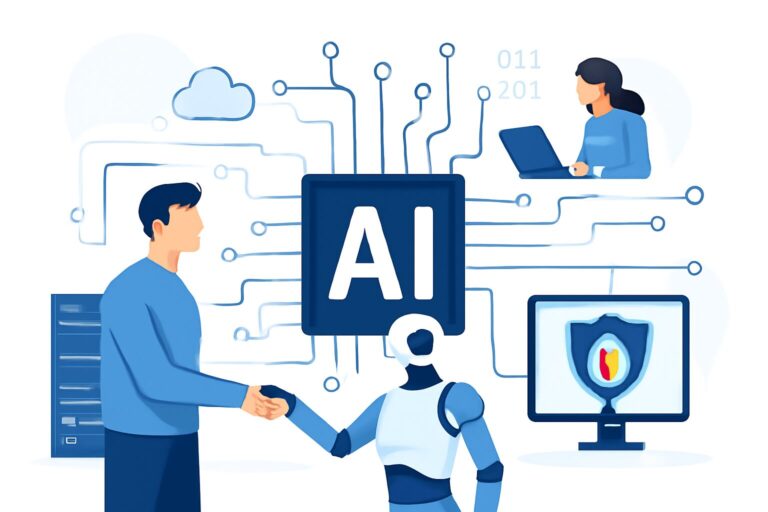# Exploring 5 Exciting Blueprints for Enterprise AI Transformation: Disruptive Innovation Leading Future Business✨
Enterprise AI transformation is rapidly becoming a core driving force in the global business arena. As the wave of digitalization surges, how enterprises leverage AI technology to achieve intelligent upgrades and drive business model innovation becomes vital to winning in the market. This article deeply analyzes 5 exciting blueprints of enterprise AI transformation, covering AI-driven business growth, intelligent strategic layout, technical architecture upgrades, organizational change to unleash potential, and performance evaluation paths, helping you gain a panoramic view of future intelligent decisions and build lasting competitiveness.
—
## Enterprise AI Transformation: Initiating a New Era of Intelligent Business 🚀
Enterprise AI transformation is not only a technological revolution but a fundamental reshaping of business models. By deeply integrating AI technology, from data-driven precise marketing to intelligent supply chain management, enterprises are achieving unprecedented efficiency and innovation. AI enables companies to optimize algorithms and automate operations, reducing costs, enhancing customer experience, and responding promptly to market changes.
In early stages, many organizations face challenges in technology selection and application scenario targeting. However, successful enterprises generally adopt a customer-centric approach, prioritizing AI projects that directly enhance business value, such as intelligent customer service, predictive analytics, and automated workflows. This not only improves operational efficiency but also significantly increases revenue.
According to McKinsey’s 2023 report, enterprises with mature AI capabilities outperform peers by an average of 25% in business performance. This statistic vividly illustrates the massive boost AI transformation brings to competitiveness. Case in point, Amazon leveraged machine learning to optimize inventory, successfully reducing operational costs by over 20%, further confirming AI’s key role in enhancing core enterprise competitiveness.
—
## Exciting Blueprints of Enterprise AI Transformation: Driving Business Growth with AI 📈
The core goal of enterprise AI transformation blueprints is to achieve sustained business growth. Through AI-driven business, companies can realize precise customer insights, intelligent decision support, and automated operations, forming an innovative ecosystem loop.
Firstly, accurate customer profiling and personalized recommendations are critical for AI-driven sales growth. Using machine learning to analyze massive user data, enterprises can precisely identify customer needs and potential value, delivering personalized products and services. For example, Netflix’s recommendation system based on user behavior data significantly increases viewing duration and customer stickiness.
Secondly, AI applications enhance operational efficiency and greatly alleviate manual workload. Automated processes like robotic process automation (RPA) accelerate business handling speeds while reducing human errors. General Electric (GE) utilizes AI to optimize equipment maintenance strategies, lowering downtime and boosting productivity.
Moreover, AI-driven business intelligence and predictive analytics help enterprises anticipate market trends and optimize resource allocation. The banking industry employs AI risk assessment models to reduce non-performing loans and improve asset quality.
In summary, a comprehensive enterprise AI transformation blueprint should balance customer value enhancement and operational efficiency improvement; their synergy forms a solid foundation for continuous business growth.
—
## Revolutionary Intelligent Strategies: Key Trends for Future Enterprise AI Transformation 🔮
Future enterprise AI transformation strategies will no longer be limited to point technology applications but will represent a systematic integration of digitalization and intelligence.
**Core Prediction**: AI will fully embed into all facets of enterprise operations—from marketing and R&D to supply chain management—without exception. Intelligent assistants, real-time data analytics, and smart robots will become standard tools.
Digital transformation is not just information upgrade but the foundation empowering deep AI application. Enterprises build unified data platforms to achieve cross-departmental data interconnection, providing rich and accurate data support for AI models. Cloud computing and edge computing collaborate to ensure efficient AI system response and flexible scalability.
Especially noteworthy, enterprise AI transformation will emphasize ethics and security, ensuring AI decisions are transparent, fair, and compliant. Enterprises will leverage AI to promote sustainable development goals, improving economic benefits and undertaking social responsibilities.
Intelligent strategies should also include building an open and collaborative ecosystem, leveraging external innovation resources to form a win-win business network. Only by comprehensively considering these key trends can enterprises remain undefeated in the future market.
—
## Disruptive Technical Architecture: Building a Robust and Efficient Foundation for Enterprise AI Transformation 🛠️
The technical architecture of enterprise AI transformation is the hard-core support for intelligent decisions and business innovation. Future AI infrastructure must be elastic, intelligent, and highly secure.
Cloud-native architecture is the preferred choice for enterprises to build AI platforms. It supports rapid iteration and elastic scaling, helping companies cope with load fluctuations and complex business needs. For example, Google Cloud uses cloud-native services to support the rapid training and deployment of AI algorithms, significantly improving R&D efficiency.
Edge computing provides AI applications with low latency and real-time computing capabilities. IoT devices collect data and perform AI inference at the edge, greatly enhancing response speed and data privacy protection. This is especially suitable for manufacturing, smart city scenarios, among others.
Additionally, multimodal AI technology—integrating vision, language, and sensor data—is maturing, opening more possibilities for business innovation. Regarding security, zero-trust architecture and encryption technologies must be adopted to ensure confidentiality and integrity during data transit.
By constructing a comprehensive technical architecture, enterprises can achieve stable AI output and thereby unleash innovation potential.
—
## Remarkable Organizational Change: Unlocking Team Potential to Propel Enterprise AI Transformation 🚀
Technological changes must be paired with organizational transformation to truly unleash enterprise AI potential. The key to driving enterprise AI transformation lies in building an agile culture and talent reshaping.
Agile culture emphasizes rapid iteration, cross-department collaboration, and continuous improvement. AI project teams should embrace an experimental mindset, quickly validating hypotheses and optimizing AI models and business processes through feedback. Netflix exemplifies this culture by encouraging employees to embrace failure to foster innovation.
Regarding talent, enterprises need to cultivate multi-disciplinary talents who understand both AI technology and business thinking. Simultaneously, enhancing digital literacy for all employees builds an “AI-aware” organizational atmosphere. Through internal training, external recruitment, and university cooperation, a diversified talent pipeline is established.
Leadership is also critical; management must actively champion AI transformation, setting clear strategies and providing resource support. Change management mechanisms need updating to ensure organizational adaptability to technology and market changes.
—
## Exceptional Implementation Path: Measuring Business Returns and Continuous Optimization of Enterprise AI Transformation 📊
Successful enterprise AI transformation goes beyond technological implementation to continuously track and assess business value.
Key indicators include ROI (Return on Investment), customer satisfaction improvements, operational cost reductions, market share growth, and the number of innovation projects. Data-driven performance management enables enterprises to scientifically evaluate AI investments and adjust strategies accordingly.
Building an AI application ecosystem loop is core to continuous optimization—encompassing data collection, model training, application feedback, and iteration upgrades—to form a self-driving intelligent system. Alibaba, for example, leverages big data and user feedback to continuously optimize recommendation algorithms, maintaining market leadership.
In addition, an open platform strategy aggregates more external resources to foster cross-industry innovation. Enterprises should regularly conduct risk assessments and compliance reviews to ensure AI applications conform with policies and regulations.
In conclusion, enterprise AI transformation is a long-term evolutionary process. Only through scientific implementation paths and continuous optimization can AI’s commercial potential be fully realized.
—
## Frequently Asked Questions
**How long does enterprise AI transformation take?**
Typically 1–3 years depending on enterprise scale and industry. SMEs may pilot quickly; large enterprises require phased implementation.
**How should SMEs start AI transformation?**
Start from pain points by selecting low-cost, easily implemented AI solutions like intelligent customer service and sales forecasting to gradually build capability and data assets.
**How to measure success of AI transformation?**
Use KPIs such as revenue growth rate, customer retention, operational efficiency improvements, combined with qualitative feedback to comprehensively evaluate effects.
**What is the impact of AI transformation on enterprise talent?**
AI transformation creates new roles and raises digital skill requirements. Enterprises should provide ongoing education and training to upgrade talent.
**How do enterprises ensure AI data security?**
Employ encryption, access control, and zero-trust architecture to safeguard data during transmission and storage.
**Do enterprises need external partners to aid AI transformation?**
Yes, leveraging AI service providers and research institutions accelerates transformation and reduces technical risks.
—
## Conclusion
Enterprise AI transformation has become the core engine of future business competition. Only by deeply understanding exciting AI transformation blueprints, scientifically planning intelligent strategies, building robust technical architectures, and driving organizational change can extraordinary business results be achieved. Digital and intelligent integration is the only way to sustained enterprise growth. Act now and embrace the future of intelligent business warfare! 🌟
For comprehensive enterprise AI transformation solutions and expert support, welcome to visit our company website [De-Line Official Site](https://www.de-line.net), embarking on your intelligent innovation journey together!
—
*This article references authoritative reports from McKinsey, Gartner, and leading industry practices to ensure content reliability and authority.*
************
The above content is provided by our AI automation poster




